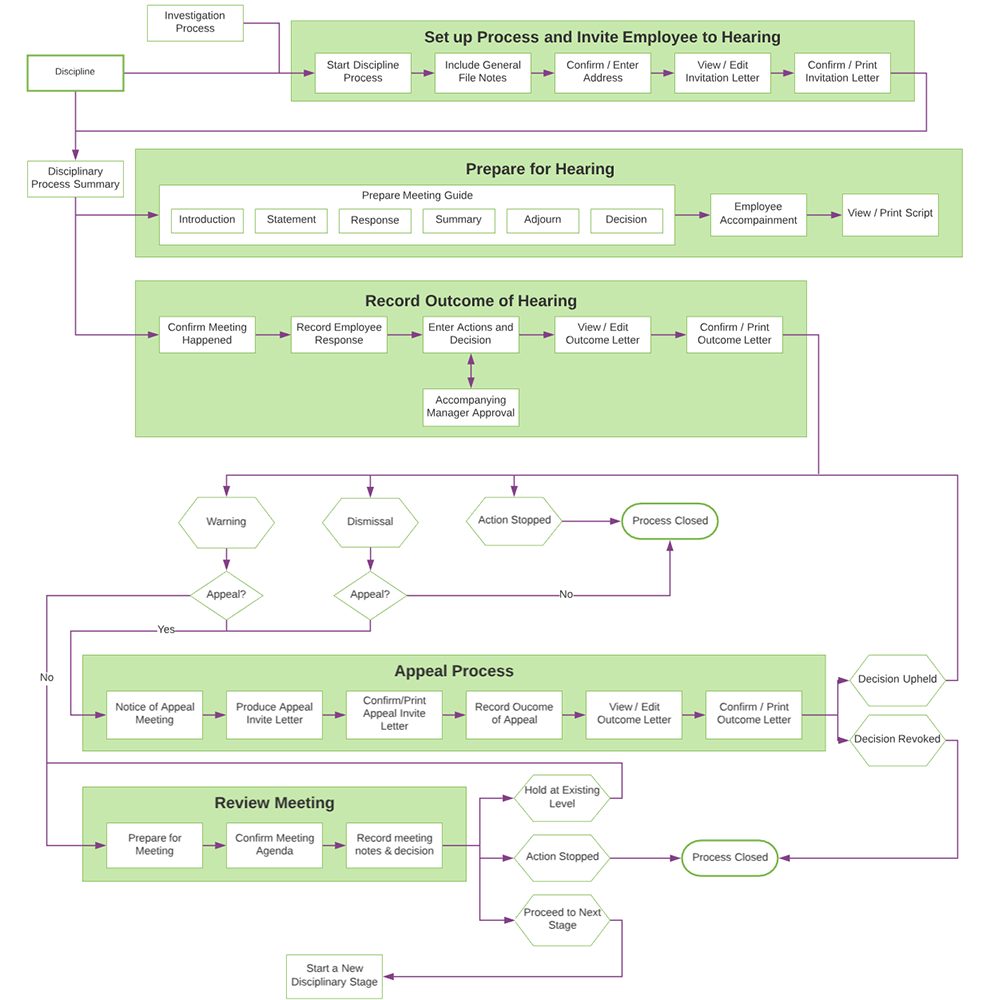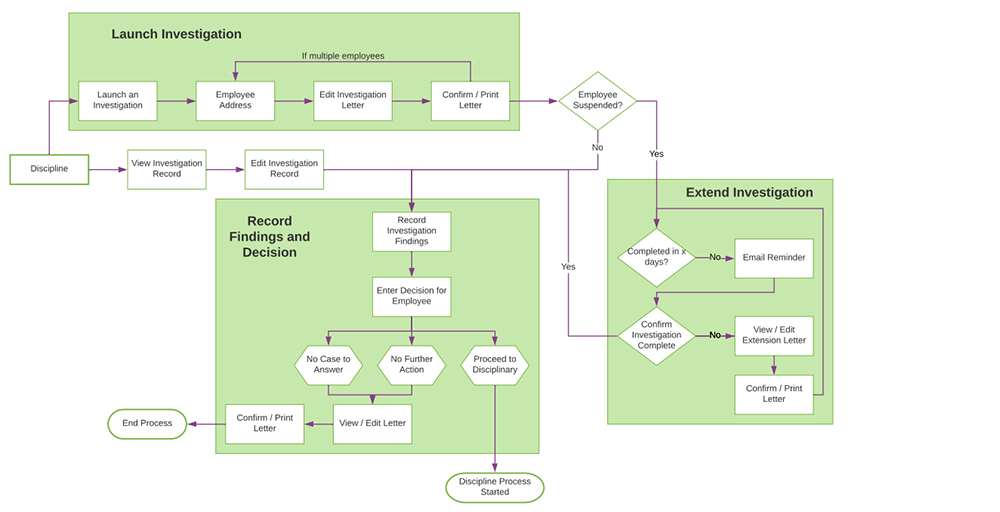A disciplinary refers to the action that an employer takes to correct an employee’s behaviour. The employer may be concerned about the employee’s work, their general conduct, or an unauthorised absence, for example.
The word ‘disciplinary’ usually refers to the hearing itself. This is the meeting at which both the employer and the employee present their case, but is only one part of the entire disciplinary process.
The term ‘discipline’ is used to cover any action by an employer in relation to an employee which is designed to correct the employee’s behaviour in response to a perceived misdemeanour, wrongdoing, or refusal of duty by the employee.
Empowering people managers to manage disciplinary and grievance processes is a crucial part of delivering HR best practice in any organisation.
This issue impacts employees at all levels, and it’s important to handle the process professionally and to be compliant at every stage in the process.
The typical disciplinary procedure
Your organisation’s disciplinary procedure should be clearly stated in your company handbook or referred to in the employee’s contract of employment.
Disciplinary processes that are poorly handled can result in accusations of unfair dismissal, which may lead to an employment tribunal. If your disciplinary policy is a contractual right, then you will equally expose the company to a breach of contract claim. Therefore, it’s imperative that you have a procedure that is thought-through and written well, and is one that you strictly adhere to.
The disciplinary procedure should set out what actions your company will take if rules are broken and outline each step of the disciplinary process. This should include the various levels of disciplinary action – such as written warnings and dismissal.
The procedure should also provide a non-exhaustive list of what behaviour or actions are likely to be considered as gross misconduct, and how an employee can appeal any disciplinary sanction.
What are the steps before a disciplinary happens?
When a minor misdemeanor takes place, the initial step would be for the employee’s line manager to speak to the employee in question on an informal basis. This is the best course of action to take, as sometimes the supposed misdemeanor may be a simple misunderstanding. Usually this step is enough to resolve most issues.
However, when something more serious happens – racial abuse, homophobic abuse, religious discrimination, or gender discrimination, for example – then a formal disciplinary procedure should be put in motion, as such action would be considered gross misconduct.
There are specific minimum steps that must be included in any disciplinary procedure, as set down in UK law. These are known as the ‘statutory minimum procedures’. They are:
- An invite letter giving reasonable advance warning, setting out the reason(s) the employer is taking disciplinary action and clear identification of any possible outcome should the allegations be substantiated
- A disciplinary meeting between the employer and the employee to discuss the issue
- To be given the right to representation
- A disciplinary decision
- A chance for the employee to appeal this decision
Suspension
You may wish to suspend the employee whilst the offence is investigated further. The employer must adequately inform the employee of the suspension and the reason(s) for the suspension. The employee should also be suspended on full pay, unless their contract of employment states otherwise. This ensures that the employee retains their employment rights, and your company can avoid a claim for unlawful deduction of wages.
Investigation
If a formal disciplinary procedure is initiated, then it is likely that you will need to carry out an investigation to establish the known facts of what happened. You may ask the employee for a statement at this point. The investigation must be unbiased, fair, and reasonable. You should also give copies of any information that comes out of the investigation to the employee.
If the employee chooses to resign at this point of the process, you can still proceed with the investigation if you wish to do so, but ensure you get a written letter of resignation.
The disciplinary hearing
The disciplinary hearing (also known as a ‘meeting’) must happen before any disciplinary action is taken. The meeting should be:
- Arranged at a reasonable time
- In a private place
- At a time that has given the employee adequate time to prepare
You should ensure that copies of any written evidence if provided to the employee at the same time as they are invited to the hearing.
During the meeting, the employee should be allowed to question any witnesses, but you can choose to take statements from witnesses instead if they don’t wish to be identifiable.
The employee must also be allowed to bring their own witnesses to the hearing, provided the evidence they plan to give is relevant to the allegations against them.
At the hearing, you should explain the complaint in detail and go through all of the evidence.
The employee should then get the opportunity to present their own evidence in their defence, and should also be permitted to ask questions and raise objections.
If the employee is unable to attend the meeting – if they’re off sick, for example – you should rearrange the meeting at least once, if possible.
If the employee is still unable to attend then you can hold the meeting in their absence, but only if you have given prior warning.
Disciplinary decision
If the decision is taken to dismiss the employee, do not give the decision on the same day as the hearing – do so after 24 hours have passed. All other sanctions can be provided after the hearing and should always be followed-up in writing.
The outcome could be:
- No action
- A written warning
- A final warning
- Demotion
- Dismissal
The outcome could also be something which could resolve the issue, such as an agreement for the employee to mediate with the complainant.
Disciplinary appeal
After the disciplinary hearing, the employee should be given the right to appeal the decision made against them. After an appeal has been made, the employee – if they feel aggrieved – can take their case to an employment tribunal.
They can appeal against the decision if they think:
- The decision was wrong
- Unfair procedures were used
- The punishment is too harsh
- New evidence has come to light
The grounds for appeal must be reasonable. The appeal process is very much like the disciplinary procedure itself:
- You receive a letter from the employee stating their reasons for appealing
- A meeting is held (usually with a more senior manager than was at the first meeting)
- A final decision is made
In SMEs, it may not be possible to find someone with a higher authority than the person who took the original disciplinary decision. If the same person has to attend the appeal hearing, then that person must act as unbiased as possible and should strive to use the meeting as an opportunity to fairly review the original decision.
If the employee chooses to take their case to an employment tribunal, the possible grounds for making a claim include:
- Unlawful discrimination in the disciplinary procedure
- Breach of statutory rights, such as being disciplined for joining a trade union
- Constructive dismissal (if the employee feels they had to resign because of the disciplinary action)
- Unfair dismissal
In addition, the employee can also make a breach of contract claim through a civil court if they believe you have broken the terms of their contract and the disciplinary procedure is a contractual right.
How to stay compliant during a disciplinary process
As you can see, a disciplinary is an extremely long and arduous process, which requires a lot of administration and meticulous record-keeping if you want to ensure that procedures are correctly followed.
The best way to remain compliant, and to ensure that the process is completed in an efficient manner, you should use an HR platform that can do the following:
- Produce a meeting guide, based on pre-loaded guidance content
- Access relevant guidance content at each step
- Create situation-specific letters based on client-editable templates
- Record and append any witness statements
- Alerts to notify users of the expiry of any time period specified
- Re-assign responsibilities to others where required
- Record any outcomes and attach any documentary evidence and correspondence
Configurable investigation settings
Your chosen HR platform should give you the ability to configure your own settings for investigations, such as the maximum number of days an investigation should take when an employee is suspended.
You should also have the ability to configure different letter templates for specific outcomes, which is very important for ensuring that the correct information is relayed at the right time.
Dashboard
Your chosen platform should have a well-designed dashboard, or landing page, which displays all of the current investigation processes relating to employees who you have access to.
This page should give you a snapshot of what’s going on with disciplinary processes to ensure you stay on top of them.
The information it should provide is:
- Reason for disciplinary
- Date started
- Meeting date
- Current stage of process
- Next action required
- Outcome from previous stage
- Name of disciplinary or appeal manager
- Review date
Investigation workflow
When you launch an investigation process in the platform, it should gather as much relevant information as possible. It should ask you the following:
- What is the allegation to be investigated?
- What is the background to this investigation?
- What is the investigation launch date?
- What is the name of the investigating manager?
- Will the employee be suspended whilst the investigation is carried out?
- What investigation letter template would you like to use?
You should also be able to add as many employees as is necessary to the investigation.
Once the investigation has been carried out and the meeting with the employee(s) have taken place, you should have the ability to record the outcome on the HR system, as well as being able to upload relevant documents such as witness statements, photos, or meeting notes, for example.
From here, you should be able to select one of two choices: either no further action required (which would then present you with the relevant letter template to send to the employee), or proceed to disciplinary. This would then start the disciplinary process.
Disciplinary process in the HR software
Your chosen HR platform should provide full disciplinary workflow capability that follows these steps:
- Meeting preparation (with the ability to record an agenda to refer to during the meeting)
- Produce follow-up notes and actions
- Decision letter
- Employee appeals
- Review meeting
After this, if the employee wishes to file a grievance complaint, then your chosen HR software should give you the ability to start a grievance procedure. The platform should ask you to enter relevant details such as who the employee is and a summary of the grievance and meeting details.
Summary
As you can see, the workflow process for an investigation and grievance procedure is very complex, so it’s imperative that the HR software you choose can provide all of the above features to ensure you remain compliant and that grievance procedures are completed to a high standard. For a visual reference, you can find the workflows for an investigation and grievance procedure below. When you are in negotiation with an HR software provider, you can show them the workflows and ask them if they can provide this functionality for you.
Investigation process

Disciplinary process







